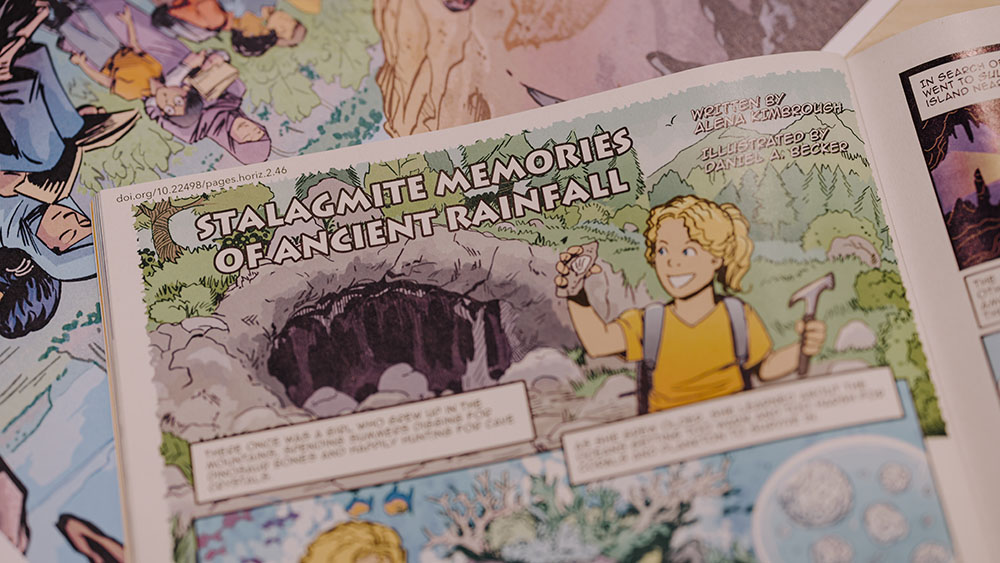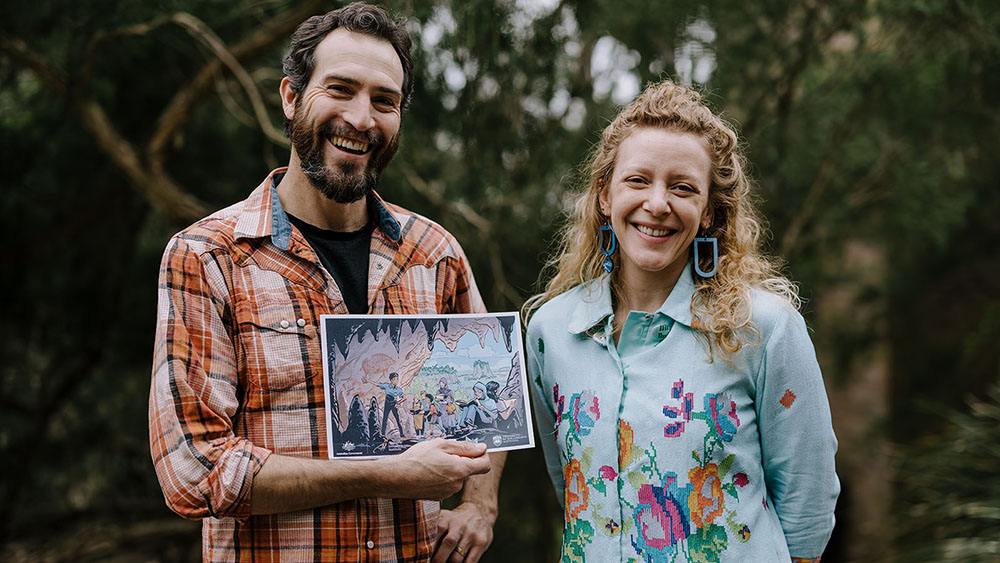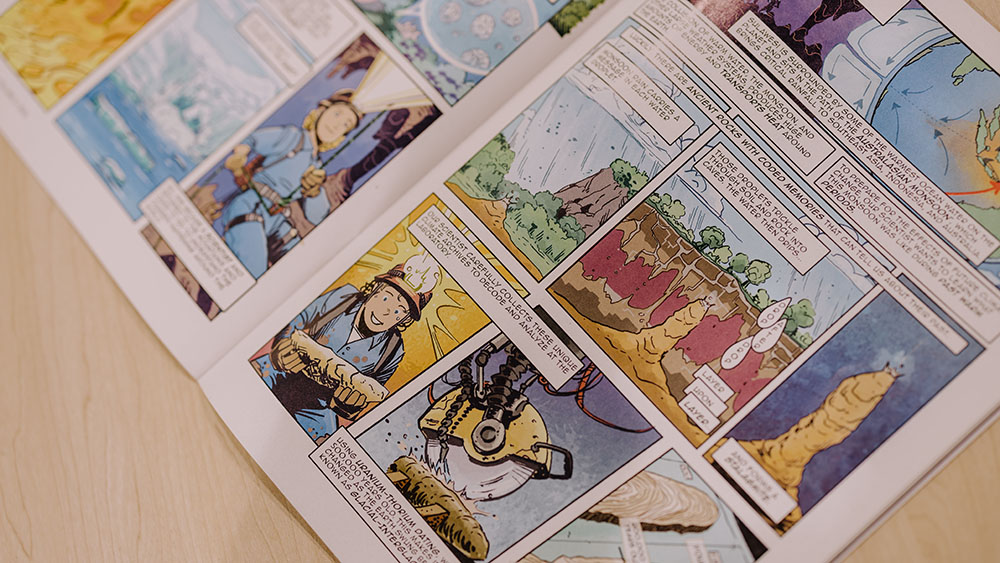Comic books bring complexity of climate science to life
Dr Ali Kimbrough and artist Daniel Becker collaborate on unique art and science project.
September 3, 2024
In a world where science often remains locked behind layers of complexity and indecipherable language, one researcher is on a mission to bring the wonders of her research to the world.
Dr Ali Kimbrough, a paleoclimatologist in the University of Wollongong’s (UOW) School of Earth, Atmospheric and Life Sciences, has spent years exploring geochemical changes in stalagmites to understand how the climate has changed over hundreds-of-thousands of years. It is a field that can be deeply complex, but one that reveals so much about the evolution of Earth’s climate and environment.
Now, with the help of a talented artist, Daniel Becker, Dr Kimbrough has embarked on an ambitious project: creating a bespoke comic book that weaves the marvels of science into a captivating narrative.
 Page from Dr Ali Kimbrough's upcoming comic book, illustrated by Daniel Becker. Photo: Michael Gray.
Page from Dr Ali Kimbrough's upcoming comic book, illustrated by Daniel Becker. Photo: Michael Gray.
Dr Kimbrough’s research sites are located in the Maros Regency on the Indonesia island of Sulawesi. In 2023, areas of the Maros and Pangkep Regencies in South Sulawesi were designated a UNESCO Global Geopark, which refers to an international site of geological significance managed with a holistic concept of protection, education, and sustainable development.
Dr Kimbrough has spent years exploring the caves of Maros, which contain information about the past 500,000 years. She is passionate about sharing knowledge of the intricacy and value of these special sites with the surrounding communities in Sulawesi. Dr Kimbrough believes this type of knowledge can empower and inspire communities to protect the caves and natural spaces within the geopark.
“This is a site that is incredibly important for researchers,” Dr Kimbrough said. “But so many of the nearby communities aren’t aware of the scientific significance of the caves. Research is often just published in journals and scientific papers, but as scientists, it is equally important to take the time to engage with communities, explain why we are working in an area, and what we have found.
“Art is a way to bridge the gap between science and society, a chance to educate through the magic of storytelling.”
Dr Kimbrough, an Associate Research Fellow in the Environmental Futures Research Group, examines stalagmites from the Sulawesi caves to understand how the climate changed as the Earth underwent dramatic transitions, from ice ages, when sea level was up to 120m lower than it is today, to warm periods, when ice sheets rapidly melted and global temperatures increased with rising C02. She also hopes to use stalagmite geochemistry to piece together evidence of land use and natural disasters in this critical region of early human history.
Securing an Australian-Indonesia Institute Grant from the Australian Government’s Department of Foreign Affairs and Trade, Dr Kimbrough has begun working with Daniel Becker, a Port-Kembla based digital illustrator, on two custom comic books that captures the cultural and scientific significance of South Sulawesi, as well as local folklore from the Maros and Pangkep Regencies. The team are collaborating with the Maros Pangkep UNESCO Global Geopark and experts within the Indonesian Ministry of Education, Culture, Research, and Technology.
Their goal is clear — transform the intricate tapestry of the region’s scientific discoveries and the extraordinary sites where they take place, into accessible and engaging tales.
 Dr Kimbrough is working with Port Kembla artist Daniel Becker on the upcoming comic book. Photo: Michael Gray.
Dr Kimbrough is working with Port Kembla artist Daniel Becker on the upcoming comic book. Photo: Michael Gray.
Dr Kimbrough and Mr Becker’s comic books are more than mere illustrations; they are a connection between complex concepts and curious minds.
“It is so important for scientists to translate their work in a way that is honest, engaging, and easy to understand. This is how we encourage audiences to care about our discoveries, to understand the importance of scientific research and the need to protect these valuable ecological sites,” Dr Kimbrough said.
To kick off the project, Dr Kimbrough and Mr Becker facilitated workshops in Sulawesi with local scientists and cultural heritage experts, gathering content for the comics and obtaining a better understanding of the local needs and hopes for the project. “Incorporating local voices and storytelling in these comics is critical to generate real connections between places and people,” Mr Becker said.
“Comics and visual storytelling are inherently inclusive and accessible tools for science outreach and education. They provide an effective medium for communicating and inspiring people of all genders, ages, and backgrounds.”
In close collaboration with the Geopark and local scientists, the series will be designed to disseminate cultural and scientific knowledge to youth, visitors, and surrounding communities. Produced in both English and Bahasa Indonesia, it will be distributed to the Maros Pangkep UNESCO Global Geopark, local teachers and schools and placed at the Geopark sites for visitors.
“The Island of Sulawesi has a unique geologic past, rife with tectonic collisions, volcanism, young coral reef islands, and vast ranges of towering limestone mountains filled with hundreds of caves. These caves are incredibly important, sheltering galleries of the world’s oldest figurative rock art and housing ancient cave deposits, known as stalagmites, that form deeper within the caves. Some of these stalagmites lived through ice ages and diligently recorded past climate and environmental changes within each layer of growth. The Maros-Pangkep region also contains remarkable biodiversity, attracting scientists from all over the world, including naturalist Alfred Wallace, who spent his time in Sulawesi contributing to the early development of evolutionary theory. This is a very special place on Earth. The goals of the comic books are to promote education and conservation, and to empower the local communities with new knowledge.” Dr Kimbrough said.
“Daniel’s incredible illustrations can bring science to life and connect readers to their environment in a new way. We hope that these stories convey that the geosites are worth preserving and protecting.”
 Page from Dr Ali Kimbrough's upcoming comic book, illustrated by Daniel Becker. Photo: Michael Gray.
Page from Dr Ali Kimbrough's upcoming comic book, illustrated by Daniel Becker. Photo: Michael Gray.
The pair recently spent two weeks in Sulawesi, meeting with their collaborators and working alongside the local communities, an experience they described as beautiful, inspiring, and eye opening. They will return early next year, with the completed comic books, to deliver educational workshops.
“Everything we do is with the input of our collaborators in Sulawesi. We’ve been working closely with the Maros Pangkep UNESCO Global Geopark, local scientists, educators, and National Park staff to gain input into the content of the comic books, which will capture the geology, climate and human histories, and biodiversity of the region as well as local folklore.
“We hope these will become valued resources for classrooms and for visitors to the geosites, and help people understand the extraordinary importance of the Maros Pangkep region.”
Mr Becker said it is a joy to work alongside Dr Kimbrough and bring complex scientific concepts to life through vibrant illustrations.
“There is a real hunger for this sort of knowledge, and the work we have completed so far captures that wonder in a way that is fun and engaging. To reveal a complex scientific discovery through art is to transform the abstract into the tangible. It is such an interesting and fulfilling project to be part of.”